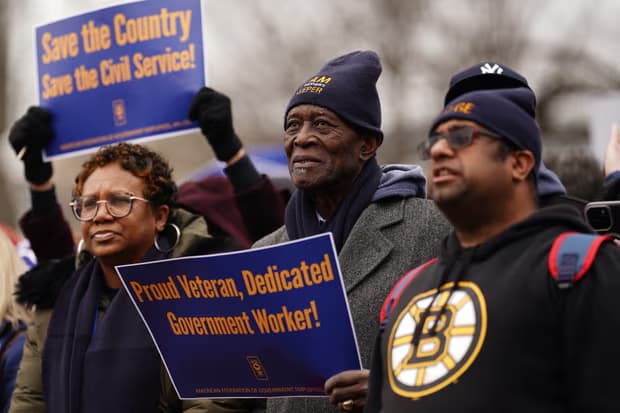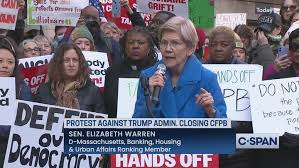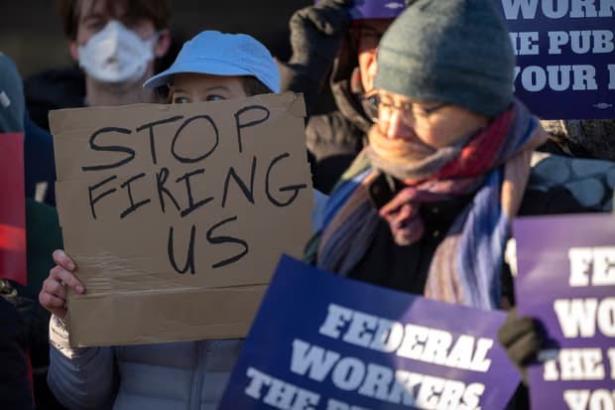As a presidential candidate last fall, Donald Trump repeatedly promised to battle for US workers, but ever since he returned to the White House, he has taken a surprisingly large number of anti-worker actions, labor experts say. Some of those moves, among them hobbling the National Labor Relations Board, will help Trump’s billionaire business friends, most notably Elon Musk and Jeff Bezos.
In his first few weeks back in office, Trump fired the acting chair of the National Labor Relations Board (NLRB), leaving the US’s top labor watchdog without a quorum to enforce laws that protect workers’ right to unionize. Trump has designated Musk, a vehemently anti-union billionaire, to launch an all-out war against the federal bureaucracy and workforce, and Trump and Musk have essentially treated the country’s 2 million-plus federal employees as if they were disposable.
Not stopping there, Trump fired two members of the Equal Employment Opportunity Commission (EEOC), leaving it without a quorum to carry out its mission of fighting against discrimination. In his crusade to downsize the government and demolish the “deep state”, Trump and his administration have fired thousands of federal employees – moves that union officials say have violated laws and rules that require due process and a finding of poor performance before workers can be dismissed.
“Donald Trump is showing that his promises to be a champion of workers are hollow,” said Judy Conti, government affairs director of the National Employment Law Project, a worker advocacy group. “He surrounds himself with people who are anti-worker. He has a history of being anti-worker, but he tries to put a nice face on it. He says he’s a champion of workers. He’s just not.”
In a move that many federal workers found distasteful, Trump asked them to snitch on each other, to inform on co-workers engaged in diversity, equity and inclusion activities. The Trump administration further angered federal employees, as well as the labor movement, by announcing that it would nullify contracts reached with federal employee unions in the final weeks of the Biden administration.
Last month, just hours after an American Airlines jet collided with an army helicopter over Washington DC, killing 67 people, Trump dissed and angered Federal Aviation Administration employees, when he denounced diversity, equity and inclusion (DEI) policies as fostering incompetence and suggesting that many FAA employees were unqualified. In another move upsetting worker advocates, Trump named Russell Vought, one of the architects of the controversial rightwing blueprint Project 2025, to run the White House budget office. Project 2025 is brimming with anti-worker recommendations, among them abolishing all government employee unions across the US.
“Trump has already shown that he’s not a friend of working people,” Liz Shuler, president of the AFL-CIO, the country’s main union federation, said in an interview. “Project 2025 is playing out exactly as we feared, and America’s workers are right at the heart of those attacks.”
One Trump move that particularly upset labor leaders was his order to fire Gwynne Wilcox, the NLRB’s acting chair and a Democrat, even though her term ran until 2026 and even though the labor board is an independent agency. That left the five-member board with just two positions filled and thus without a quorum to make decisions (although its regional offices can still operate).

Protesters gather at a rally organised by the American Federation of Government Employees near the US Capitol on Tuesday. Photograph: Will Oliver/EPA
Calling her dismissal “unprecedented” and a “blatant violation” of the law, Wilcox is suing Trump and asking to be reinstated. “He does not have the authority to remove a board member unless they have engaged in neglect of duty or malfeasance,” Wilcox said in an interview. She noted that Trump never gave any reasons for firing her and failed to give advance notice or allow for a hearing.
“Their practical point was to prevent any work from being done,” Wilcox said. “It’s counter to what the agency is supposed to do, which is to protect the rights of working people and enforce the law.”
In defending that firing, the Trump administration asserted that Trump had the power to dismiss any executive branch employee he wishes. That claim is expected to be litigated all the way to the supreme court.
The AFL-CIO’s Shuler said: “The illegal firing of Gwynne Wilcox – we’re fighting that tooth and nail. It did exactly what Trump wanted to do, which was stymie the one agency that workers rely on when they’re in an organizing drive and taking risks and getting fired. They no longer have the board they need to protect them.” Ben Sachs, a Harvard labor law professor, added: “If you believe in unions and in workers’ rights to organize and bargain collectively, then dismantling the NLRB is not the way to show one’s support for workers.”
Musk’s company SpaceX – which the NLRB has accused of firing several workers illegally – has brought suit in federal court to have the NLRB declared unconstitutional. Amazon, which was founded by Jeff Bezos, has brought a similar lawsuit after NLRB officials found that Amazon broke the law numerous times in fighting against unionization.
“We know the corporations that Musk and Bezos run have expressed a clear interest in shutting down the NLRB and have deployed teams of lawyers to accomplish that,” Sachs said. “Now they’ve got their way, at least temporarily.” If federal courts order Wilcox’s reinstatement, the NLRB would again have a quorum, enabling it to operate.
Trump also fired two EEOC commissioners, Charlotte Burrows and Jocelyn Samuels, leaving it too without a quorum. He also fired members of two boards that hear cases in which federal employees assert they have been improperly fired or treated: the Merit Systems Protection Board and the Federal Labor Relations Authority.
“All of these are agencies where workers who believe their rights have been violated can go to get remedies,” said Conti of the National Employment Law Project. “They’re essentially freezing the ability of these boards to remedy workers’ problems.”

Congressional Democrats Protest Closing CFPB. C-SPAN.org
Mark Gaston Pearce, executive director of the Workers’ Rights Institute at Georgetown University, said it was disturbing that Trump, instead of firing one of the NLRB’s two white members, fired Wilcox, the only African American woman to serve on the NLRB in its 90-year history. Pearce asserted that Trump’s and Musk’s firing of hundreds of federal workers involved in DEI programs was disproportionately hitting workers of color. “It’s all code for getting rid of people of color,” Pearce said.
An African American official who worked at the Department of Education for more than 15 years and who insisted on anonymity said she was recently put on paid administrative leave merely because she had once participated in a DEI training. She said she had no idea whether she would be reinstated. “They’re vilifying the civil service,” she said. “It feels like a betrayal.”
Linda Ward-Smith, president of an American Federation of Government Employees union local representing 4,000 Veterans Administration workers in Las Vegas, said many federal employees were disgusted with how they had been treated. “Workers are telling me it’s a hostile work environment due to all the emails they’re receiving” – including Musk’s “Fork in the Road” email to 2 million federal employees suggesting they take buyouts and messages saying the Trump administration wants loyal employees. “They’re scared,” she said. “They feel the sky is going to fall.”
Ward-Smith said Trump’s and Musk’s attacks on DEI were making many workers of color anxious and thinking of leaving their government jobs. Several African American and female workers said they felt even more unwelcome when Trump appoints people like Darren Beattie, a former Trump speechwriter, to a top state department position even though Beattie once said: “Competent white men must be in charge if you want things to work.”
Conti defended the federal government’s longtime effort to promote workforce diversity. “It is to promote true, full meritocracy,” Conti said. “It is not about quotas. It is not about not hiring white people. It is about removing the barriers that people of color, women, LGBTQ and other disadvantaged people face to compete for jobs for which they are qualified.
“What people need to know,” Conti continued, “is this is not some sort of targeted campaign against employment practices that have gone too far. It is a broad-based campaign to roll back our country’s civil rights protections. Full stop.”
Steven Greenhouse is a journalist and author, focusing on labour and the workplace
Why you can rely on The Guardian not to bow to Trump – or anyone
I hope you appreciated this article. Before you move on, I wanted to ask whether you could support the Guardian’s journalism as we begin to cover the second Trump administration.
As Trump himself observed: “The first term, everybody was fighting me. In this term, everybody wants to be my friend.”
He’s not entirely wrong. All around us, media organizations have begun to capitulate. First, two news outlets pulled election endorsements at the behest of their billionaire owners. Next, prominent reporters bent the knee at Mar-a-Lago. And then a major network – ABC News – rolled over in response to Trump’s legal challenges and agreed to a $16m million settlement in his favor.
The Guardian is clear: we have no interest in being Donald Trump’s – or any politician’s – friend. Our allegiance as independent journalists is not to those in power but to the public. Whatever happens in the coming months and years, you can rely on the Guardian never to bow down to power, nor back down from truth.
How are we able to stand firm in the face of intimidation and threats? As journalists say: follow the money. The Guardian has neither a self-interested billionaire owner nor profit-seeking corporate henchmen pressuring us to appease the rich and powerful. We are funded by our readers and owned by the Scott Trust – whose only financial obligation is to preserve our journalistic mission in perpetuity.
What’s more, we make our fearless, fiercely independent journalism free to all, with no paywall – so that everyone in the US can have access to responsible, fact-based news.
With the new administration boasting about its desire to punish journalists, and Trump and his allies already pursuing lawsuits against newspapers whose stories they don’t like, it has never been more urgent, or more perilous, to pursue fair, accurate reporting. Can you support the Guardian today?
We value whatever you can spare, but a recurring contribution makes the most impact, enabling greater investment in our most crucial, fearless journalism. As our thanks to you, we can offer you some great benefits – including seeing far fewer fundraising messages like this. We’ve made it very quick to set up, so we hope you’ll consider it. Thank you.
Betsy Reed Editor, Guardian US


Spread the word